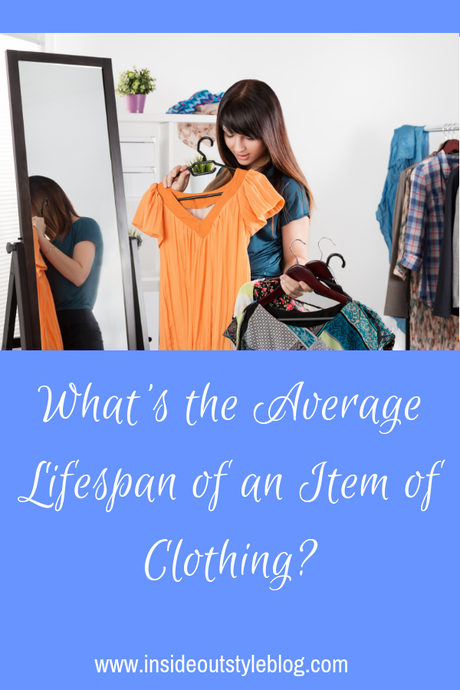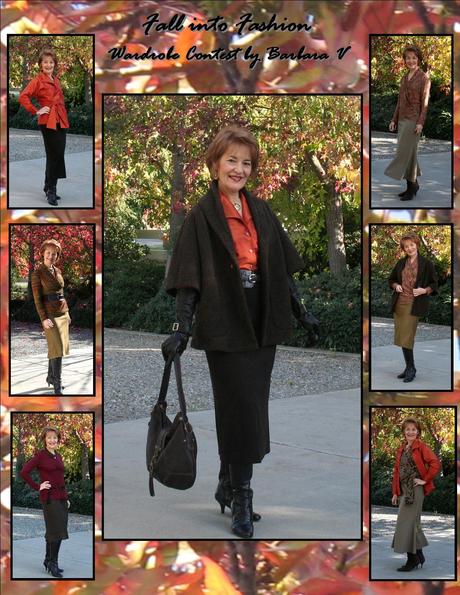I've written posts on the fashion lifecycle - fads - trends and classics, and also the expected lifespan of different fabrics and clothing. And whilst doing research on these topics, I stumbled over research on how long people actually keep their clothes - and thought it was quite fascinating and wanted to share some salient points with you.
Firstly, what I learned is that the people who hang on to clothes the longest are:
- More mature
- Low income
- More highly educated
- Have a large wardrobe (of over 200 items and so have a high number of items they have not worn in the past 12 months)
- Conscious shoppers who look to buy clothes that last and look good longer.
What Gets Thrown Out the Most Quickly?
Based on this list - it would be the lower quality clothing, the poorer quality fabrics and fast fashion items that are not made to last.
The research shows that the
- Leggings
- Bras
- Underwear
- Socks
- Casual at home clothing worn every day inside the home and garden
- Casual outside home clothing and clothing for work
are the items that have the shortest lifespan.
You can imagine that underwear/bras/socks/tights - because of their "one wear and wash" nature will wear out much more quickly and therefore the turnover of them is faster.
The casual clothing category is interesting - as we generally invest less in a casual tee to wear at home than we do for a top we wear to work - and those lower quality tees then wear out more quickly, particularly if they are worn in the garden and doing chores where there is a higher chance they will become stained (cooking/cleaning) or torn (gardening).
Interestingly the clothes for outside the home also didn't have a particularly long lifespan. In my experience going through wardrobes, women tend to purchase fewer "work" clothing and more "fun" clothing - and so each work item gets worn and worn more frequently, thus reducing its lifespan more quickly.

The Clothes We Keep the Longest Are
- Formal Wear
- Sports/Outdoors clothing
- Jackets/Blazers/Coats
What is is about these clothes that make them last longer?
For most of us, formal wear gets worn rarely - maybe a couple of times a year - so it is not getting much wear at all and should last a long long time!
Sports/outdoor clothing - often we invest more in a great outdoor jacket or specific purpose outdoor clothing - thus it being higher quality and made to last.
Now, how about that activewear? I'm not sure - for some it could be like formal wear (rarely worn by those who buy with the intention of doing more exercise but don't end up doing it) or it could be a better quality fabric and made for all that stretching and bending - so it lasts longer. It's hard to tell from the data.
Jackets/Coats and Blazers are obvious - they are generally better made, from higher quality fabrics, and made to last. Plus their styles change less quickly than other fashion items, many fall into the Classic category and so turnover on these items is much lower.
How Many Clothes Does the Average Person Have in Their Wardrobe?
Excluding footwear and accessories, the average is 127 items.
Those who have average to larger wardrobes include:
- Women
- Middle-aged
- More highly educated
- Higher income
And how much of that has been unworn in the past 12 months? The average was 26 items - around 1/5th of the wardrobe size. Who has the most unworn clothing in their wardrobe (higher than the average)?
This is interesting data. I can surmise from my experience why middle-aged women are more likely to wear less of their wardrobes. From having done many wardrobe audits for clients in this demographic the reasons are:
- Things that have been kept, but are out of fashion, but just haven't been let go of (so go unworn and can sit in a wardrobe for years before someone like me comes along and helps them let those items go)
- Changing body shape - things may not fit like they should - weight gain most commonly or menopausal change in body shape - with the owner of the wardrobe wanting to get back to the weight so they can wear the item again (thus keeping these items but not wearing them).
- Having lived longer, and acquired more over time, having little time for themselves to audit wardrobes (everyone else in the family comes first before their own needs) and time going faster, so not realising that clothes have become truly dated.
Low income is interesting - given that lower income means smaller wardrobes on the whole - and apparently, it's because they have more items that have worn out more quickly than they expected as they were purchasing poorer quality to start with.
How Long Do We Really Keep Most Clothes
A study of 620 items disposed of in a 6 month period by 16 households in Norway found that the average lifespan of a garment was 5.4 years but only actively worn for a period of 4 years.
Around 8% of those items disposed of in this study were completely unworn by anyone, and every 5th garment was either never used or only worn a couple of times. Most interestingly this study showed that a high proportion of the "never used" items were gifts or inherited items (this is because with gifts the item may not be your style, taste or the right size). What is fascinating about the inherited and 'gifted' items from others is that these were kept much longer than average. In my experience, it's not because they are being worn, it's because there is a feeling of guilt for wanting to get rid of an item that was given with love or care. I've written about how to handle this guilt here.
A second reason why some clothes don't get much wear is that they are high-maintenance - and require special care - handwashing or dry cleaning - and many of us see the garment as "work" if we wear it, so choose to wear other clothes instead.
Thirdly, you just can't see them to wear them - poorly organised wardrobes mean that clothes get lost at the back of draws, on the bottom layer of a hanger with multiple items etc. Can't see it - won't wear it!
Why Do We Get Rid of Clothing Items?
What are the reasons people get rid of their clothing? There are a few reasons I'm aware of from the time spent in wardrobes helping people dispose of what is not working for them:
- Wrong size - no longer fits because of weight loss or gain
- Wrong shape - just doesn't flatter their body shape/proportions
- Wrong colour - doesn't make them look healthy, vibrant and alive - as colours that flatter you should
- Wrong style - doesn't fit their personality or personal style - very often these items are bought because the owner is bored with their current wardrobe so they buy 'different' but sadly it's the wrong kind of different (and they don't know how to buy the right kind of different for them - something you learn in my 7 Steps to Style)
- Not fit for purpose - bought it for a reason but it didn't really work for the purpose you bought it for
- Not your lifestyle - I've seen this many times - purchasing an item of clothing for an imagined or hoped for life that doesn't exist in your real world, or a changing lifestyle - work to retirement or child-rearing, change of location and climate.
- Out of fashion - find out how you can figure this out for yourself here.
- Worn out - pilled, stained, torn, saggy, baggy etc.
Middle-aged (adults over 51) kept their clothing for longer before disposing of it when it was 10 years old. Many of these 10-year-old items had not been worn for some years but had been kept for some time before disposal (letting go can be hard for many).
While teenagers kept theirs for only 3 years at most (not unexpectedly, as this is both a period of changing body shapes and size, but also a time of self-discovery and trying out different fashions and following fashion fads, also garments made for this demographic are generally of poorer quality).
What was interesting, was that if clothing was going to be disposed of and it was still in good condition - so it would be either sold or donated - it was let go of more quickly at around 3 years after purchase (letting others get wear out of it while still in fashion) than if it was going to be thrown in the bin (then it was kept for 1.6 years longer).
So if you don't want to have clothes in your wardrobe you don't wear - say no to the "gifts" that really are a burden not a gift and learn more about what suits you so you can make informed and conscious shopping choices.
The more you know about your body, colouring and personal style - the better the decisions you'll make when choosing what to buy and what to keep in your wardrobe.
More Reading on Decluttering Your Wardrobe
3 Reasons Your Wardrobe is a Kitchen
3 Easy Tests To Know if You Should Keep it Or Let it Go
How to Love Everything in Your Wardrobe More
8 Tips to Help You Declutter Your Wardrobe
Listen.... Do You Hear That? What is Your Body Telling You About Your Wardrobe?
Change of Seasons - Changing Your Wardrobe
Which 3 Little Words Will Kill Your Style?
Why You Should Imagine Your Body is a Room


